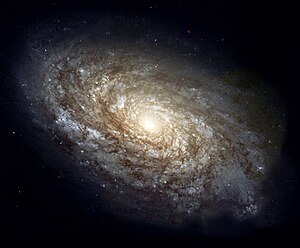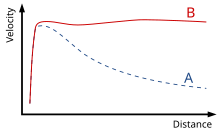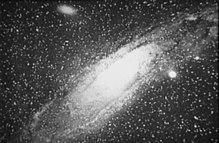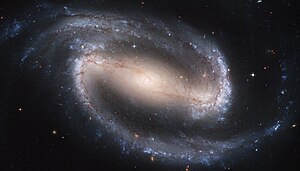
NGC 4414, a typical spiral galaxy in the constellation Coma Berenices, is about 55,000 light-years in diameter and approximately 60 million light-years away from Earth.
Galaxies contain varying amounts of star systems, star clusters and types of interstellar clouds. In between these objects is a sparse interstellar medium of gas, dust, and cosmic rays. Dark matter appears to account for around 90% of the mass of most galaxies. Observational data suggests that supermassive black holes may exist at the center of many, if not all, galaxies. They are thought to be the primary driver of active galactic nuclei found at the core of some galaxies. The Milky Way galaxy appears to harbor at least one such object.[5]
Galaxies have been historically categorized according to their apparent shape; usually referred to as their visual morphology. A common form is the elliptical galaxy,[6] which has an ellipse-shaped light profile. Spiral galaxies are disk-shaped with dusty, curving arms. Those with irregular or unusual shapes are known as irregular galaxies and typically originate from disruption by the gravitational pull of neighboring galaxies. Such interactions between nearby galaxies, which may ultimately result in a merging, sometimes induce significantly increased incidents of star formation leading to starburst galaxies. Smaller galaxies lacking a coherent structure are referred to as irregular galaxies.[7]
There are probably more than 170 billion (1.7 × 1011) galaxies in the observable universe.[8] Most are 1,000 to 100,000[9] parsecs in diameter and usually separated by distances on the order of millions of parsecs (or megaparsecs).[10] Intergalactic space (the space between galaxies) is filled with a tenuous gas of an average density less than one atom per cubic meter. The majority of galaxies are organized into a hierarchy of associations known as groups and clusters, which, in turn usually form larger superclusters. At the largest scale, these associations are generally arranged into sheets and filaments, which are surrounded by immense voids.[11]
Etymology
The word galaxy derives from the Greek term for our own galaxy, galaxias (γαλαξίας, "milky one"), or kyklos ("circle") galaktikos ("milky")[12] for its appearance in the sky. In Greek mythology, Zeus places his son born by a mortal woman, the infant Heracles, on Hera's breast while she is asleep so that the baby will drink her divine milk and will thus become immortal. Hera wakes up while breastfeeding and then realizes she is nursing an unknown baby: she pushes the baby away and a jet of her milk sprays the night sky, producing the faint band of light known as the Milky Way.[13][14]In the astronomical literature, the capitalized word 'Galaxy' is used to refer to our galaxy, the Milky Way, to distinguish it from the billions of other galaxies. The English term Milky Way can be traced back to a story by Chaucer:
When William Herschel constructed his catalog of deep sky objects in 1786, he used the name spiral nebula for certain objects such as M31. These would later be recognized as immense conglomerations of stars, when the true distance to these objects began to be appreciated, and they would be termed island universes. However, the word Universe was understood to mean the entirety of existence, so this expression fell into disuse and the objects instead became known as galaxies.[15]"See yonder, lo, the Galaxyë
Which men clepeth the Milky Wey,
For hit is whyt."—Geoffrey Chaucer. The House of Fame, c. 1380.[12]
Observation history
The realization that we live in a galaxy, and that there were, in fact, many other galaxies, parallels discoveries that were made about the Milky Way and other nebulae in the night sky.Milky Way
The Greek philosopher Democritus (450–370 BC) proposed that the bright band on the night sky known as the Milky Way might consist of distant stars.[16] Aristotle (384–322 BC), however, believed the Milky Way to be caused by "the ignition of the fiery exhalation of some stars which were large, numerous and close together" and that the "ignition takes place in the upper part of the atmosphere, in the region of the world which is continuous with the heavenly motions."[17] The Neoplatonist philosopher Olympiodorus the Younger (c. 495–570 AD) was scientifically critical of this view, arguing that if the Milky Way were sublunary it should appear different at different times and places on the Earth, and that it should have parallax, which it does not. In his view, the Milky Way was celestial. This idea would be influential later in the Islamic world.[18]According to Mohani Mohamed, the Arabian astronomer Alhazen (965–1037) made the first attempt at observing and measuring the Milky Way's parallax,[19] and he thus "determined that because the Milky Way had no parallax, it was very remote from the Earth and did not belong to the atmosphere."[20] The Persian astronomer al-Bīrūnī (973–1048) proposed the Milky Way galaxy to be "a collection of countless fragments of the nature of nebulous stars."[21][22] The Andalusian astronomer Ibn Bajjah ("Avempace", d. 1138) proposed that the Milky Way was made up of many stars that almost touch one another and appear to be a continuous image due to the effect of refraction from sublunary material,[17][23] citing his observation of the conjunction of Jupiter and Mars as evidence of this occurring when two objects are near.[17] In the 14th century, the Syrian-born Ibn Qayyim proposed the Milky Way galaxy to be "a myriad of tiny stars packed together in the sphere of the fixed stars".[24]
Actual proof of the Milky Way consisting of many stars came in 1610 when the Italian astronomer Galileo Galilei used a telescope to study the Milky Way and discovered that it is composed of a huge number of faint stars.[25] In 1750 the English astronomer Thomas Wright, in his An original theory or new hypothesis of the Universe, speculated (correctly) that the galaxy might be a rotating body of a huge number of stars held together by gravitational forces, akin to the solar system but on a much larger scale. The resulting disk of stars can be seen as a band on the sky from our perspective inside the disk.[26] In a treatise in 1755, Immanuel Kant elaborated on Wright's idea about the structure of the Milky Way.
Distinction from other nebulae
In 1750 Thomas Wright, in his An original theory or new hypothesis of the Universe, speculated (correctly) that Milky Way was a flattened disk of stars, and that some of the nebulae visible in the night sky might be separate Milky Ways.[26][32] In 1755, Immanuel Kant introduced the term[where?] "island universe" for these distant nebulae.
Toward the end of the 18th century, Charles Messier compiled a catalog containing the 109 brightest nebulae (celestial objects with a nebulous appearance), later followed by a larger catalog of 5,000 nebulae assembled by William Herschel.[26] In 1845, Lord Rosse constructed a new telescope and was able to distinguish between elliptical and spiral nebulae. He also managed to make out individual point sources in some of these nebulae, lending credence to Kant's earlier conjecture.[33]
In 1912, Vesto Slipher made spectrographic studies of the brightest spiral nebulae to determine if they were made from chemicals that would be expected in a planetary system. However, Slipher discovered that the spiral nebulae had high red shifts, indicating that they were moving away at rate higher than the Milky Way's escape velocity. Thus they were not gravitationally bound to the Milky Way, and were unlikely to be a part of the galaxy.[34][35]
In 1917, Heber Curtis had observed a nova S Andromedae within the "Great Andromeda Nebula" (as the Andromeda Galaxy, Messier object M31, was known). Searching the photographic record, he found 11 more novae. Curtis noticed that these novae were, on average, 10 magnitudes fainter than those that occurred within our galaxy. As a result he was able to come up with a distance estimate of 150,000 parsecs. He became a proponent of the so-called "island universes" hypothesis, which holds that spiral nebulae are actually independent galaxies.[36]
The matter was conclusively settled in the early 1920s. In 1922, the Estonian astronomer Ernst Öpik gave a distance determination which supported the theory that the Andromeda Nebula is indeed a distant extra-galactic object.[38] Using the new 100 inch Mt. Wilson telescope, Edwin Hubble was able to resolve the outer parts of some spiral nebulae as collections of individual stars and identified some Cepheid variables, thus allowing him to estimate the distance to the nebulae: they were far too distant to be part of the Milky Way.[39] In 1936 Hubble produced a classification system for galaxies that is used to this day, the Hubble sequence.[40]
Modern research

Rotation curve of a typical spiral galaxy: predicted (A) and observed (B). The distance is from the galactic core.
In the 1970s it was discovered in Vera Rubin's study of the rotation speed of gas in galaxies that the total visible mass (from the stars and gas) does not properly account for the speed of the rotating gas. This galaxy rotation problem is thought to be explained by the presence of large quantities of unseen dark matter.[43][44]
Beginning in the 1990s, the Hubble Space Telescope yielded improved observations. Among other things, it established that the missing dark matter in our galaxy cannot solely consist of inherently faint and small stars.[45] The Hubble Deep Field, an extremely long exposure of a relatively empty part of the sky, provided evidence that there are about 125 billion (1.25×1011) galaxies in the universe.[46] Improved technology in detecting the spectra invisible to humans (radio telescopes, infrared cameras, and x-ray telescopes) allow detection of other galaxies that are not detected by Hubble. Particularly, galaxy surveys in the Zone of Avoidance (the region of the sky blocked by the Milky Way) have revealed a number of new galaxies.[47]
Types and morphology
Galaxies come in three main types: ellipticals, spirals, and irregulars. A slightly more extensive description of galaxy types based on their appearance is given by the Hubble sequence. Since the Hubble sequence is entirely based upon visual morphological type, it may miss certain important characteristics of galaxies such as star formation rate (in starburst galaxies) and activity in the core (in active galaxies).[7]Ellipticals
The Hubble classification system rates elliptical galaxies on the basis of their ellipticity, ranging from E0, being nearly spherical, up to E7, which is highly elongated. These galaxies have an ellipsoidal profile, giving them an elliptical appearance regardless of the viewing angle. Their appearance shows little structure and they typically have relatively little interstellar matter. Consequently these galaxies also have a low portion of open clusters and a reduced rate of new star formation. Instead they are dominated by generally older, more evolved stars that are orbiting the common center of gravity in random directions. The stars contain low abundances of heavy elements because star formation ceases after the initial burst. In this sense they have some similarity to the much smaller globular clusters.[48]The largest galaxies are giant ellipticals. Many elliptical galaxies are believed to form due to the interaction of galaxies, resulting in a collision and merger. They can grow to enormous sizes (compared to spiral galaxies, for example), and giant elliptical galaxies are often found near the core of large galaxy clusters.[49] Starburst galaxies are the result of such a galactic collision that can result in the formation of an elliptical galaxy.[48]
Spirals
Spiral galaxies consist of a rotating disk of stars and interstellar medium, along with a central bulge of generally older stars. Extending outward from the bulge are relatively bright arms. In the Hubble classification scheme, spiral galaxies are listed as type S, followed by a letter (a, b, or c) that indicates the degree of tightness of the spiral arms and the size of the central bulge. An Sa galaxy has tightly wound, poorly defined arms and possesses a relatively large core region. At the other extreme, an Sc galaxy has open, well-defined arms and a small core region.[50] A galaxy with poorly defined arms is sometimes referred to as a flocculent spiral galaxy; in contrast to the grand design spiral galaxy that has prominent and well-defined spiral arms.[51]In spiral galaxies, the spiral arms do have the shape of approximate logarithmic spirals, a pattern that can be theoretically shown to result from a disturbance in a uniformly rotating mass of stars. Like the stars, the spiral arms rotate around the center, but they do so with constant angular velocity. The spiral arms are thought to be areas of high-density matter, or "density waves".[52] As stars move through an arm, the space velocity of each stellar system is modified by the gravitational force of the higher density. (The velocity returns to normal after the stars depart on the other side of the arm.) This effect is akin to a "wave" of slowdowns moving along a highway full of moving cars. The arms are visible because the high density facilitates star formation, and therefore they harbor many bright and young stars.[53]
Our own galaxy is a large disk-shaped barred-spiral galaxy[57] about 30 kiloparsecs in diameter and a kiloparsec thick. It contains about two hundred billion (2×1011)[58] stars and has a total mass of about six hundred billion (6×1011) times the mass of the Sun.[59]





Tidak ada komentar:
Posting Komentar